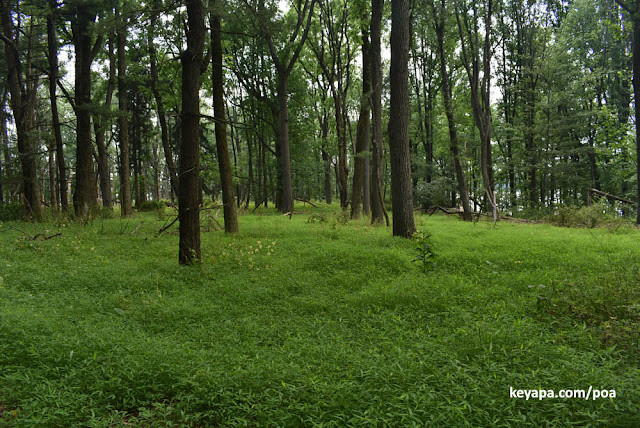The Wildflower Trail is a 1.3 km paved trail that follows along the route Gen. Stonewall Jackson took when he marched from the Shenandoah Valley to Fredericksburg through New Market, Virginia.
I had some time in between hikes in Shenandoah and so I had decided to visit this very easy trail in search of one of the newest invasive grasses in the country.
 |
| Trudging deeper into the woods |
Oplismenus undulatifolius (Wavyleaf Basketgrass) was first discovered in the 1990s in Patapsco State Park in Maryland (Peterson et al, 1999). It is a very shade-tolerant perennial grass that reputedly can crowd out competitors and cover the dark understory of forests. It is currently found only in Maryland, Virginia, West Virginia, and Pennsylvania (one treated colony), and some specimens have been found as far west as the Shenandoah area (EDDSMaps, 2020). Its ability to thrive in as low as 2-11 mols m(-2) day(-1) means it can occupy niches where even the dreaded
Microstegium vimineum (Stiltgrass) has trouble dominating.
It should be noted that a native species of this genus (
Oplismenus hirtellus and perhaps others) is also found in the United States, mostly in the Southeastern part of the country, and should not be confused with this non-native invader. They can be distinguished by the fact
O. undulatifolius is conspicuously hairier and has white flowers, whereas
O. hirtellus has purplish or reddish flowers.
 |
| The fallen logs |
The entrance to the Wildflower Trail is pretty unobtrusive, and I would have easily missed it if I had not been using google maps to plot my way. But when I cruised into the rather large parking lot I saw that people still knew about it, because there were 5 other cars parked.
 |
| The surprise find |
Heartened by the presence of other hikers, I trudged into the trail and made my way deeper into the forest. There were smatterings of
M. vimineum along the sides, but none of the other many plants looked like the pictures of
O. undulatifolius that I had seen on the web.
 |
| Rippled leaves |
The trail ended in a circular open space, and I still had not found any evidence of the invasive grass. Instead of going back to my car in defeat, I decided to press on into the woods, and I slowly made my way forward where the piles of decaying leaves that coated the ground was less thick.
 |
| Hairy stems |
When I spied two large fallen logs I carefully leveled myself up onto one and peered into the shadowy depression formed by their intersection. Imagine the surprise I felt when I spotted a few leaves that seemed to have the rippled surface so characteristic of
O. undulatifolius!
The grass was intermixed with masses of
M. vimineum, as well as a few other plants, and a careful search of my surroundings revealed more of the invasive (including near a large clump of stiltgrass), although never in a large enough grouping to merit unusual attention. I even found a very young specimen that even at that small stage had the characteristic rippled leaves. I was able to quickly ID the plants because in addition to the rippled leaves,
O. undulatifolius has very hair stems, and its sprawling behavior on the forest floor also helps in the identification.
 |
| Mixed in with the stiltgrass |
While hiking through trails in nearby Shenandoah National Park, I made it a point to look for the species, although the rapid pace of our hike meant my search was not very comprehensive at all. Nevertheless,
O. undulatifolius had been seen in the area, and it is being actively controlled by park management. This is because unlike
M. vimineum, which is now ubiquitous, this new invasive is still at that stage where it may be possible to control its spread.
 |
| More specimens around the base of a tree |
Although it is currently only found in Maryland, Virginia, and small outbreaks in northern West Virginia, there was a chance that it might have spread towards West Virginia from the Shenandoah area, and so when I visited Wolf Gap Recreation Area in Wardenville, WV, I combed the nearby trails and campgrounds for any signs of the species. I also visited Shrine Mont in Orkney Springs, which lies near the border of West Virginia and Virginia. In both cases, I found
M. vimineum in abundance, but no sign of the newer invasive.
 |
| Two younger individuals |
However, the spread of
O. undulatifolius to other states is something that I believe is inevitable. Vanessa Beauchamp, an invasive plant ecologist in Maryland who specializes in the species and fought valiantly to contain its spread, found that its sticky seeds stuck easily not only to people's pants legs, but also to passing animals like pet dogs. During one test, she discovered that a pet dog who run for 30 seconds in a field of
O. undulatifolius managed to pick up an amazing 2000 seeds.
Given such fecundity, and coupled to the perennial lifestyle of the species and its ability to thrive in deep forest canopies, it is probably only a matter of time before it threatens major parts of the northeastern half of the USA.
 |
| A very young specimen already has the characteristic rippled leaves |
For more on
O. undulatifolius on this site, click
here.
Literature Cited
EDDMapS. 2020. Early Detection & Distribution Mapping System. The University of Georgia - Center for Invasive Species and Ecosystem Health. Available online at http://www.eddmaps.org/; last accessed July 25, 2020.
Peterson, P.M., E.E. Terrell, E.C. Uebel, C.A. Davis, H. Scholz, and R.J. Soreng. 1999. (Scientific Note) Oplismenus hirtellus subspecies undulatifolius, A new record for North America. Castanea 64:201-202.

































